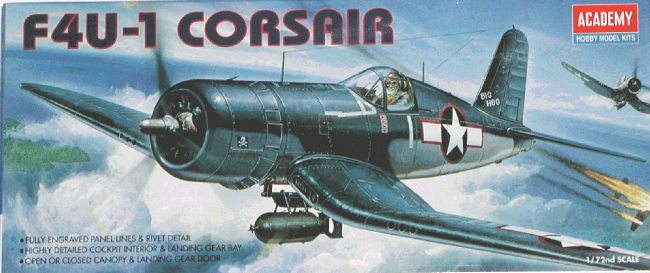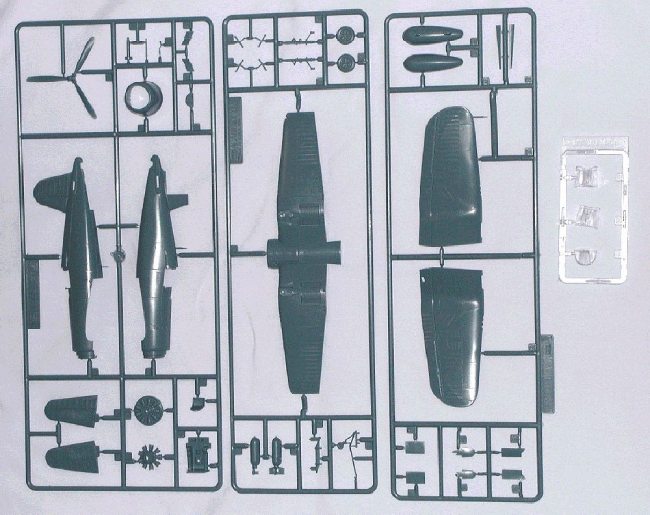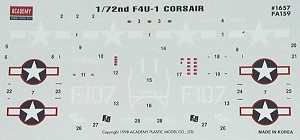
|
KIT: |
Academy 1/72 F4U-1 Corsair |
|
KIT # |
1667 |
|
PRICE: |
$9.50 |
|
DECALS: |
Two Aircraft |
|
REVIEWER: |
|
|
NOTES: |

|
HISTORY |
The F4U Corsair has to be one of the most famous aircraft
of all time. Ordered in 1938, the Corsair remained in production until
December 1952, giving it the longest production run of any World War II US
fighter.
The Dash 1 was the first model to be delivered to the Navy. They weren’t happy
with how it handled carrier landings, so they sent their first batches to
land-based units. It wasn’t until April 1944 that the Corsair cleared for
carrier use (in the US, at least). A total of 9440 Dash 1s were built in
different variants by Vought, Goodyear and Brewster.
Now is where I may get into trouble... The original F4U-1 featured a heavily
framed canopy, most commonly referred to as the “birdcage” canopy. Later
production aircraft had a higher canopy with just two frames. Officially, there
was no difference between the two (this according to Jim Sullivan’s book).
Unofficially, the newer Corsair has come to be known as the F4U-1A.
In service, three squadrons, VMF-111, VMF-224, and VF-17, fitted bomb racks to their Corsairs. Other squadrons quickly followed suit. Depending on your source, a water injected version of the Pratt & Whitney R-2800 may also have been fitted to late F4U-1As (and/or maybe retrofit to early F4U-1As). Some F4U-1As also acquired the blown canopy originally used on the later C and D models. The result of all of these improvements is that you could have an early model F4U-1A that looked similar to and had most of the performance capabilities of the later F4U-1D.
|
THE KIT |

A 1998 issue, Academy gives you your money’s worth in three nice
sprues of blue gray parts which include parts for both an external fuel tank and
your basic 500 pound bomb. Your other choice includes using either a framed
(but not birdcage) or blown canopy. The plastic itself looks very nice, with
recessed panel lines and good details. The interior is very well done for the
scale, but all of those details will have to be painted as there are no decals.
On the engine, the front row of pistons is well done while the rear row pistons
are very basic half-pistons molded to the firewall. You’re not going to see it
without a flashlight and magnifying glass anyway, but that really makes a
difference to some modellers.
An interesting feature of the F4U-1s is that part of the outer wing panels were
fabric covered. These areas on the kit are appropriately scalloped and devoid
of fabric texture that would be overscale in 1/72 anyway. The kit only has a
few small ejector pin marks to worry about. Unfortunately, they’re on the main
wheels and in a couple of hard-to-reach areas on the otherwise nice gear doors.
(I feel kind of nit-picky saying that as I won’t worry about filling them, but
some of you probably will!) You will also have to fill a small seam on the
starboard vertical stabilizer as the rudder and top corner of the right vertical
stab are
molded on the left fuselage half.
The kit instructions are easy to follow (ala Hasegawa) and take
you through nine steps to a finished model. Except for the exterior colors,
most of the color call-outs  are generic. I’d recommend checking any one of a
number of good books on the Corsair to verify detail colors. Otherwise, there
doesn’t seem to be any tricky areas to catch the novice modeller unawares.
are generic. I’d recommend checking any one of a
number of good books on the Corsair to verify detail colors. Otherwise, there
doesn’t seem to be any tricky areas to catch the novice modeller unawares.
The decals are present options for two aircraft: Tommy Blackburn’s tri-color
“Big Hog,” as on the box, and an overall glossy blue plane belonging to VMF-212.
The decals have lots of carrier film around them, but look to be in register and
fairly thin. Of course, there’s an abundance of aftermarket sheets on the
market, so your choices are much greater than those two options.
|
CONCLUSIONS |
This looks to be a nice little kit. It’s not as detailed as
the recently issued Tamiya kit, but at half the cost, I won’t complain.
Recommended to all skill levels.
Review kit courtesy of me and my wallet!
|
REFERENCES |
Mark Styling, Corsair Aces of World War 2, Osprey Aerospace, 1995
Jim Sullivan, F4U Corsair in Action (Aircraft Number 145), Squadron/Signal
Publications, 1994
Gordon Swanborough and Peter Bowers, United States Navy Aircraft since 1911,
Naval Institute Press, 1990
If you would like your product reviewed fairly and quickly by a site that has well over 150,000 visitors a month, please contact me or see other details in the Note to Contributors.